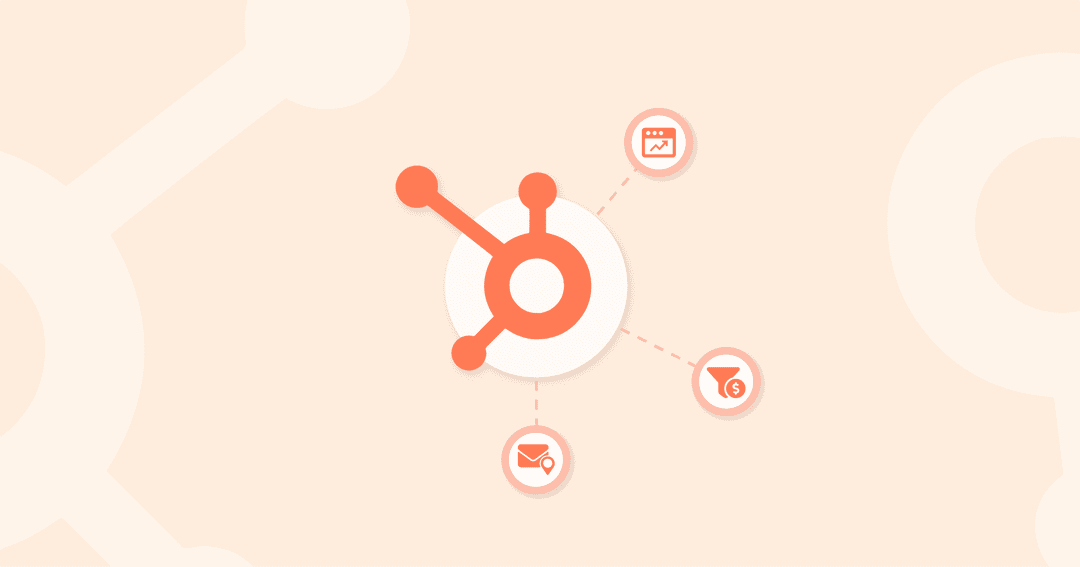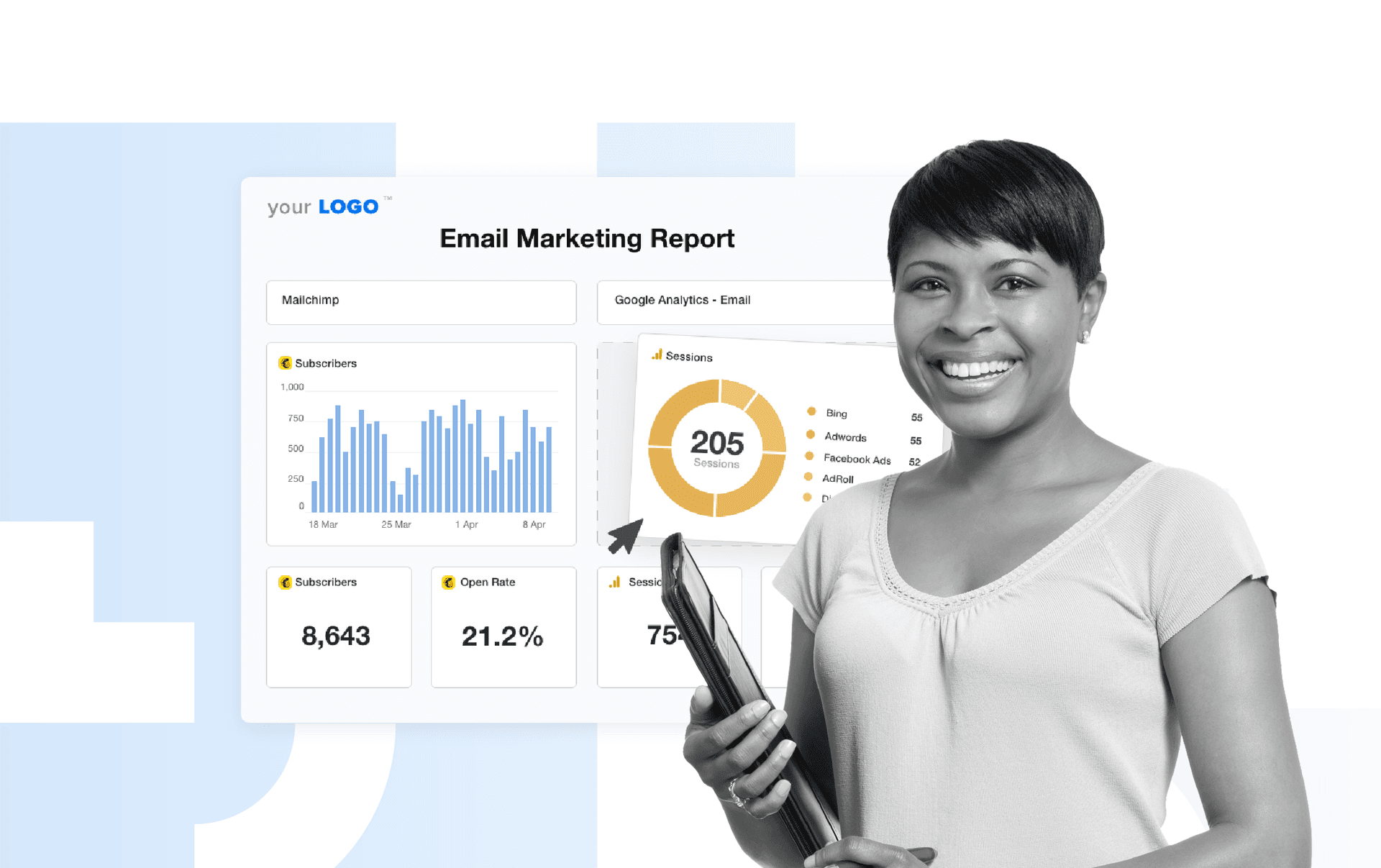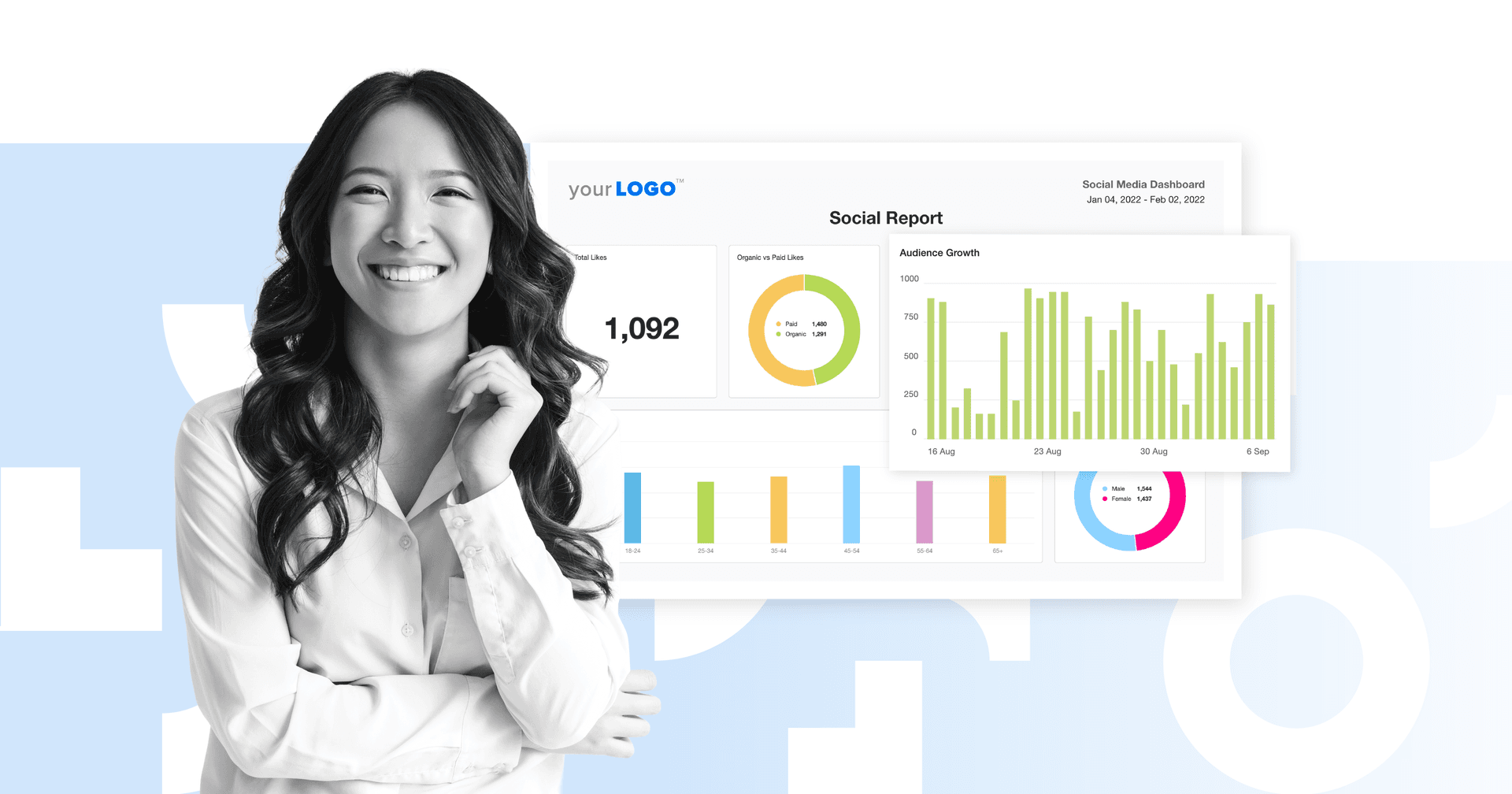Table of Contents
QUICK SUMMARY:
HubSpot Analytics is a tool for data analysis and a strategic asset for understanding and optimizing the customer journey. Its comprehensive marketing and sales data integration provides invaluable insights for developing marketing strategies. But how does your agency decide which HubSpot metrics to report on when there are so many to choose from? We'll outline the most important marketing metrics to keep tabs on.
Keeping on top of inbound marketing efforts is no easy feat, especially if you’re a scaling marketing agency. After you’ve run those social media and email marketing campaigns, your client wants to see tangible results and ROI. It’s probably why you’re using a CRM and analytics tool such as HubSpot in the first place.
The great thing about HubSpot is its robust data capabilities–from tracking traffic analytics to engagement metrics, they’ve got it all. Yet the common agency dilemma remains:
“Where do I even start? There are so many HubSpot metrics to choose from!”
Picture this—you just launched an educational video series on cosmetic dental procedures for your client. In fact, their phone has been ringing off the hook for porcelain veneer consults!
To keep the momentum going and increase web traffic, they’ve decided to create a ‘Porcelain Veneers 101’ blog series and a ‘Book a Consultation Now’ call-to-action button at the end. Their increased inbound marketing efforts, stronger brand presence, and revenue–not surprisingly–lead to client (and patient) smiles but also heightened expectations from your agency.
Not only does this client have multiple goals running in conjunction (such as racking up website views and contact submission forms), but they also want to understand the data-driven insights behind their newfound success.
After you’ve logged into your account and seen all those metrics under the ‘Marketing’ and ‘Sales’ tabs, it’s easy to get lost in the maze and not know where to begin–especially with so much happening all at once. And if you're lost, just imagine what your clients might be experiencing.
Whether your agency is just starting with HubSpot, or simply checking if you’re on the right track–this article is for you.
Let's get started...
What Is HubSpot Analytics
HubSpot Analytics represents a pivotal component in modern digital marketing, offering comprehensive insights into customer interactions and marketing effectiveness. This tool is essential for digital marketing managers seeking to enhance their strategies and better understand their audience's behavior.
Key Features of HubSpot Analytics
HubSpot Analytics provides a detailed view of customer interactions across various channels. It effectively tracks and analyzes every touchpoint in the customer journey, turning raw data into valuable insights. This process is crucial for identifying trends, optimizing strategies, and improving overall marketing performance.
Advantages of Using HubSpot Analytics
Customer Journey Insights: HubSpot Analytics offers detailed analytics on the customer journey. Tracking user interactions from new contacts to final conversion helps refine marketing strategies and improve customer engagement.
In-Depth Marketing Analytics: HubSpot Marketing Analytics enables a clear understanding of which campaigns are performing and which aren't. This insight is vital for allocating resources effectively and maximizing return on investment.
Enhanced Sales Analytics: Understanding the sales process is crucial for any marketing strategy. HubSpot Sales Analytics provides clear insights into the sales pipeline, helping to identify successful tactics and areas needing improvement.
HubSpot Metrics for Measuring Success: HubSpot Metrics offers a clear, quantifiable way to measure marketing success. These metrics are essential for evaluating the effectiveness of different strategies and making data-driven decisions.
Centralized Analytics Platform: The Analytics HubSpot is a central platform where all marketing and sales data converge. This integration ensures a holistic view of the marketing and sales performance, which is essential for comprehensive analysis and strategy development.
Why Choose HubSpot Analytics
HubSpot Analytics stands out for its user-friendly interface, making complex data analysis accessible to non-experts. Its ability to integrate diverse data sources offers a complete view of marketing and sales efforts. The platform's real-time insights ensure that strategies can be adjusted promptly in response to market dynamics.

HubSpot Analytics is not just a tool for data analysis; it's a strategic asset for understanding and optimizing the customer journey. Its comprehensive marketing and sales data integration provides invaluable insights for developing marketing strategies.
How to Select Which HubSpot Metrics To Report On
You don’t want to send a report full of vanity metrics and information that doesn’t tie into your client’s overall goals–that’s not a good look. No two clients are the same either, so it’s essential to know your HubSpot metrics thoroughly so you’re able to make informed decisions and choose the right ones.
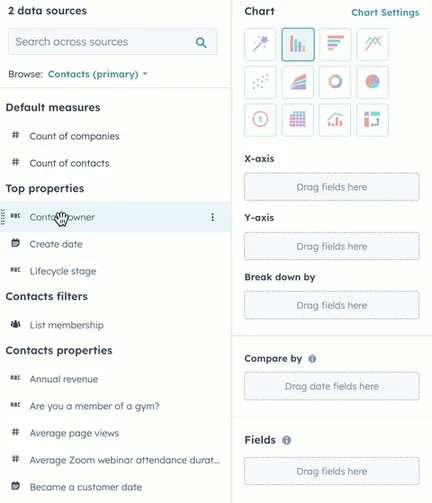
Before you send an e-mail or converse with your client on their inbound marketing efforts, decide what’s worth mentioning (or reporting on) beforehand.
Cover your bases ahead of time by considering:
What Are The Client’s Overall Strategic Goals?
Here’s the thing. While there’s an extensive suite of HubSpot metrics to pull from, don’t overwhelm your client by reporting on every metric under the sun.
Not only does it incite confusion, but it also takes your valuable time trying to explain metrics that may not even be applicable. The fix to this is:
Having an open line of communication beforehand and understanding your client’s sales and marketing goals. You’ll want to use an onboarding questionnaire to ask this during your client onboarding process and ensure that their HubSpot metrics actually tie into whatever they’re trying to achieve.
For each campaign, be as specific as possible and set SMART goals (i.e., set targets that are specific, measurable, attainable, realistic, and timely).
After you’ve decided on their goals, use the A.P.I.E. method to improve their metric results continuously over time.
Read more about HubSpot reporting best practices

Agency Tip: Set up a reporting schedule that makes sense. After all, sharing weekly HubSpot metrics won’t be your best bet if there’s significant variability within a month. To avoid inaccurate data blunders, decide on the frequency of reporting and client discussions in advance. That way, you’ll set realistic expectations early on.
What Do The Client’s Customer Journeys Look Like?
Depending on your client’s product offering, there may be various marketing campaigns for each stage of the customer journey.
For example, a client in the banking industry may promote a webinar about the benefits of opening an investment account. In this campaign, they’re targeting aspiring investors and entrepreneurs that actively looking to perform this action.

On the flip side, perhaps there’s an entirely different campaign outlining the importance of investment while in your twenties (geared towards university students in the brand awareness or consideration phases).
While the campaigns are similar, they’re each geared towards customers in entirely different phases of the buyer’s journey–and each campaign’s marketing metrics should reflect that.
Agency Tip: Take the time to map the customer journey for each client. While it may seem like a lot of upfront work, it will help your agency understand the customer experience, create relevant content for each stage, and subsequently decide on the appropriate HubSpot metrics to track.
Why HubSpot Works Well for Tracking Metrics
HubSpot has over 150,000 users worldwide, and for a good reason. When it comes to tracking metrics, this popular analytics tool is user-friendly, intuitive, and data-driven (most importantly). In a nutshell, Hubspot:
1. Enables You To Make Data-Driven Decisions
Data-driven marketing is the only route your agency should take. It informs future inbound marketing campaigns, tracks the progress of existing ones, and provides a reliable narrative for your client’s efforts. HubSpot does a great job of pooling customer data, corroborating analytical insights, and showing data across the entire sales cycle. In addition, consistently monitoring your client’s metrics will steer their business towards success and shows that your agency has robust tracking systems.
2. Offers Data Visualization
Upon first glance, a heap of numbers isn’t the most appetizing or visually appealing.
Data visualization visually identifies historical trends, presents performance over time, and fast-tracks important decisions. Luckily, HubSpot is an intuitive analytics tool that creates easy-to-reference, interactive graphs that can be filtered and tweaked as needed. The HubSpot interface is also customizable, which is especially useful if you want a quick glance at your client’s data.
The same goes for the HubSpot integration on AgencyAnalytics. This complex data is presented in an easy-to-understand format with just a few mouse clicks.
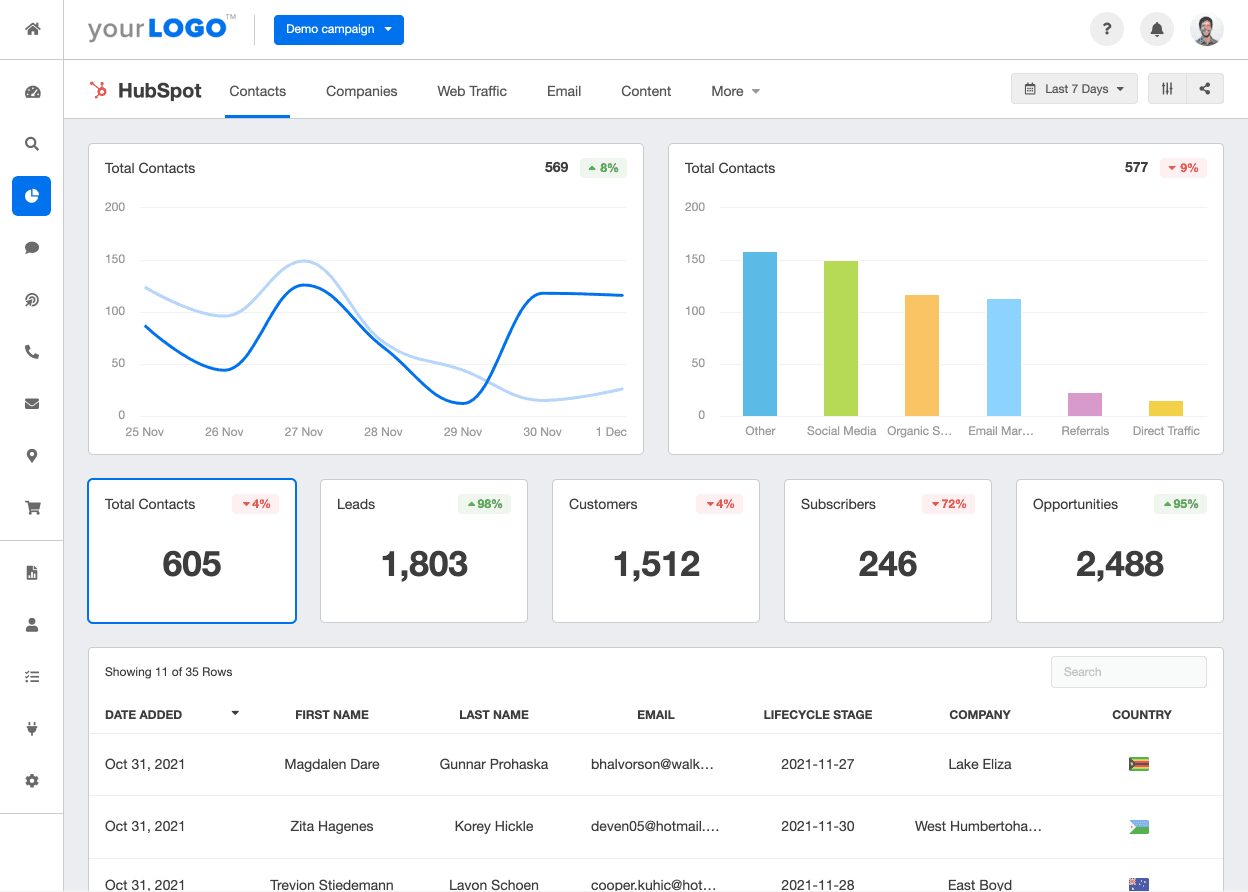
Need an easy way to streamline your agency's HubSpot reporting? Check out the HubSpot reporting template.
3. Consolidates a CRM with a Sales and Marketing Platform
If you’re managing your client’s significant customer base in addition to their campaigns, HubSpot consolidates the two for a more seamless, integrated experience. This saves you time in the long run, as you won’t have to toggle between two different platforms. It’s also easier to see any linkages between customers and campaign performance at any given time.
4. Facilitates Lead Capture and Tracking
To manage clients that are looking to generate leads continuously, HubSpot has the capability to feed information from contact forms directly into their CRM feature.
You won’t have to worry about lead information slipping through the cracks. In addition, you’ll be able to keep tabs on progress as a lead moves further down the pipeline. It also allows you to provide customer service without navigating away from the platform.
Agency Tip: HubSpot lifecycle stages map precisely where a customer is in the sales funnel. Use this feature to understand how to nurture leads and develop relevant messaging every step of the way.
31 Metrics Your Marketing Agency Should Track On HubSpot
Let’s get your agency (and clients) on the way to success! Here are the top HubSpot metrics your marketing agency should know and report on (where applicable).
Inbound Marketing Metrics
These indicators are necessary to understand how your client’s inbound efforts are performing over time.
While content may not seem like the most intuitive marketing collateral to provide metrics, you must understand what resonates with your client’s audience the most. From increasing traffic analytics to a plunging clickthrough rate, inbound marketing metrics help you to strategize ahead.
HubSpot Metric | Why It’s Important |
|---|---|
Conversion Rate | An inbound marketing conversion rate tracks how many users follow through on a call to action within your client’s blog, landing page, or webpage (i.e., filling out a contact form). This indicator gives you an idea of how content resonates with your client’s audience and the overall success of a marketing campaign (i.e., if a high conversion rate was a goal). |
Clickthrough Rate | If you’ve embedded links in your client’s content, a clickthrough rate indicates user interest and link relevance.
A favorable clickthrough rate may be an opportunity to expand on related content and acquire backlinks. |
Contact Submissions | Whether you’ve got contact forms embedded on a landing page, blog, or webpage, tracking contact submissions will give you an idea of how many users are interested in getting more information. |
Engagement | Another measure of content performance is an engagement metric, which provides insight into how much a user interacts with your client’s content. An engagement metric includes likes, shares, comments, and shares. An increasing engagement metric is an opportunity to explore similar content pieces. |
Traffic Sources | Evaluating your client’s top-performing traffic sources (e.g., search engines, social media, paid ads, etc.) will help you to make future strategic decisions.
This includes deciding on ad spend allocation, distribution channels, and new traffic sources. |
These are leads that have come through one of your client’s marketing channels but haven’t yet entered the sales pipeline. Perhaps they’re not ready to convert or put things in place for a future transaction. Whatever the case may be, tracking the MQL metric provides more insight into potential remarketing opportunities. If there’s a high MQL rate and a significant number don’t become customers, explore why this happens and create inbound marketing strategies to address it. | |
Contact-to-Customer Rate | After a lead fills out a call-to-action from your client’s content, it doesn’t necessarily mean they have become a customer. That’s where a contact-to-customer rate comes in. While there may be some influence from your client’s sales or outreach team, this metric gives insight into your client’s content performance beyond the engagement phase. |
Agency Tip: If your client has a ‘Call’ button embedded within any inbound content, consider setting up the HubSpot CallTrackingMetrics integration. This automatically generates a unique contact within the HubSpot CRM and helps your agency track campaign success.
Email Tracking
When you’re capturing email leads or after you’ve hit ‘Send’ on that HubSpot email marketing campaign, you’ll want to ensure your email engagement programs are performing well (or keep notes for future improvements). Here are important HubSpot email marketing metrics to keep an eye on.
HubSpot Metric | Why It’s Important |
|---|---|
A growing subscriber rate indicates that your client’s audience is interested in directly receiving content and further insights–which is a promising sign. On the contrary, a stagnant or declining subscriber rate is an opportunity for a new inbound strategy or improving existing ones. | |
It won’t make sense to send an e-mail marketing campaign if it doesn't deliver to who it’s supposed to. Keep an eye on the delivery rate for any significant declines, which may mean a cleanup of your client’s subscriber list is needed. | |
Regardless of your client’s email subscriber list, expect to get some bounces. However, it’s a cause for concern if there are many hard bounces (i.e., there’s no chance of delivery due to an invalid or inactive email address, in most cases). HubSpot has a 5% hard bounce limit so ensure that your client’s subscriber list is up-to-date. Especially since the consequence is dire–account suspension (yikes). | |
After you’ve expended all that effort to create an email marketing campaign, it’s a no-brainer–you want subscribers to open it! Tracking open rates over time will help you to understand the most impactful types of subject lines and what content subscribers are most interested in. | |
While you want to keep an eye on open rate, don’t neglect the importance of clickthrough rates. This metric is critical if you’ve embedded links, calls-to-action, videos, or other clickable elements within your client’s content. | |
Each time an email marketing campaign is sent, a few unsubscribes shouldn’t be a cause for concern. However, a rising unsubscribe rate could spell trouble if you don’t get it under control (especially if spam reports accompany them).
Like bounce rate, HubSpot also has a 5% unsubscribe rate limit. Therefore, you’ll want to ensure your client’s email marketing campaigns are insightful, relevant, and engaging. |
Read more about Important Email Engagement Metrics to Track.
Website Performance Metrics
Consistently keeping track of website performance provides vital insight into its health, reach, and any needed updates or improvements. Track the following HubSpot metrics to keep your client’s website in tip-top shape.
No one metric tells the overall story of your client’s website health and performance, so use each one to piece together the entire puzzle.
HubSpot Metric | Why It’s Important |
|---|---|
Page Visits | A page visit is logged whenever a user comes across your client’s website through a search engine, backlink, social media post, or any other external source. This metric provides insight into which pages receive the most visits and ideas for future content. |
Pages per session | Pages per session is an excellent metric to gauge how users navigate your client’s website for any given visit. As a benchmark, note that approximately 50% of websites observe 4-6 page views per session. |
Time on page | This metric estimates the average time a user spends on a webpage. A longer average time could mean a user finds your client’s content interesting and informative.
On the other hand, a shorter average time may mean improvements are needed (e.g., breaking up dense text for easier readability). |
Bounce Rate | Bounce rate is measured when a user visits your client’s website and doesn’t navigate to other pages or take any actions.
If you’re consistently noticing a high bounce rate (over 70%), it’s a sign to make changes. Improve your client’s bounce rate to maximize their content’s impact. |
View to Submission Rate | If your client has a contact form as a call to action, a view to submission rate is a key conversion metric to track. A favorable rate indicates that your client’s content is relevant and entices users to learn more about their product or service. |
Sales Metrics
It goes without saying–sales are one of the most crucial elements of a business. The following HubSpot metrics help you to measure your client’s sales performance month after month.
HubSpot Metric | Why It’s Important |
|---|---|
Customer Conversion Rate | For clients with calls to action that involve some sort of monetary transaction (e.g., an online purchase), you’ll want to monitor customer conversion rate.
This metric measures how many conversions occur compared to the number of website visits at any given time. |
Revenue | It goes without saying that a steady flow of income makes a business go ’round. That’s why revenue is one of the most crucial metrics to measure, especially for hitting sales targets. |
Based on your client’s existing customer base, monthly recurring revenue (MRR) estimates how much predictable revenue they can expect to receive per month.
This is especially handy for businesses with subscription-based models. Use this metric for sales forecasts, setting realistic targets, and evaluating cash flow. | |
Revenue Churn | Similar to MRR, revenue churn is an excellent metric for subscription-based businesses. This churn rate estimates how much MRR was lost for a given period, which may have resulted from customer loss or non-renewal of subscriptions. An increasing revenue churn rate means you should evaluate your client’s product for any shortcomings. At this point, it’s also a good idea to garner customer feedback for any oversights or blind spots. |
A sales qualified lead (SQL) is a high-ticket customer with strong conversion potential and interest in your client’s product or service. Identifying these leads helps you (and your client) to understand campaign effectiveness, customer needs, and any notable sales trends. |
Customer Service & Support Metrics
Happy customers = thriving business and positive brand reputation.
Add these HubSpot metrics to your radar to understand the type of support customers receive when interacting with your client’s brand.
HubSpot Metric | Why It’s Important |
|---|---|
Abandonment Rate | Abandonment rate measures the number of customers who started a conversion process and didn’t complete it (e.g., abandoning an online shopping cart or even a user failing to click ‘Submit’ on a contact form). According to a recent study, the average cart abandonment rate was 69.9% in 2022. If you notice a significantly higher rate, evaluate your client’s transaction process for improvements and determine the stage that most users abandon their transaction. |
Ticket Backlog | If your client has an online ticketing system for customer issues and inquiries, ticket backlog is a must-have HubSpot metric.
Significant backlogs may point to several possible issues, such as staff efficiency, inadequate resourcing, or system glitches. |
Average Resolution Time | Use this metric in tandem with ticket backlog to determine how long ticket resolution actually takes. Similarly, average resolution time will indicate shortcomings in the overall ticketing process (such as inadequate staff training or a need for more resources). |
Renewal Rate | Renewal rate measures just how many customers renew their subscription to your client’s product or service. A consistent or increasing renewal rate is a promising sign.
Not surprisingly, a declining rate calls for further investigation into possible causes (such as lack of customer satisfaction, irrelevant target marketing, or expensive subscription rates). |
Customer Success Metrics
Your client’s product or service should adequately satisfy customer needs. Understanding the overall customer experience and level of satisfaction is a must-know for all businesses. Here are the most important customer success metrics to track on HubSpot.
HubSpot Metric | Why It’s Important |
|---|---|
Customer retention is an integral part of many businesses, so you should keep this metric on your radar. In summary, customer retention rate (CRR) quantifies how many customers your client’s business has retained for any given period. Don’t neglect the potential of retained customers, as they can contribute to your client’s steady flow of income while also advocating for their brand. | |
Customer Satisfaction Score (CSAT) | This valuable metric gives you actual customer insight and should be a top priority. As part of your client’s overall strategy, send customer surveys at regular intervals. |
Net Promoter Score (NPS) | Similar to CSAT, Net Promoter Score (NPS) is also a measure of customer satisfaction. This metric indicates how likely a customer will recommend your client’s product or service.
After sending out a customer satisfaction survey with a rating scale of 1-10, categorize and tally responses according to the following: Promoters: A rating of 9 - 10 Passives: A rating of 7 - 8 Detractor: A rating of 0 - 6 To calculate NPS, calculate the percentage difference between the number of promoter and detractor responses. An NPS score above 50% is a good sign. |
For clients that rely on repeat customers for business, consider tracking a customer lifetime value (CLV). While there is a bit of manual work involved, it’s not difficult if you’ve got a purchase history for long-term customers. To calculate the customer lifetime value of any given customer, multiply their number of transactions by the average transaction value. |
Track the Top HubSpot Marketing Metrics All in One Dashboard
There you have it!
Tracking the right HubSpot metrics doesn’t have to be rocket science–it just takes planning and deciding what’s worth reporting on. Before diving headstrong into metrics, remember to understand your client’s strategic goals first. That way, there’s more synchronicity between what you report and what they’re trying to achieve.
You’re likely juggling multiple marketing platforms and campaigns as a thriving marketing agency. Won’t it be helpful to consolidate all those metrics into one dashboard? Luckily, it’s possible with AgencyAnalytics! With over 80+ integrations, it’s easy to create a fully customizable HubSpot dashboard and house all your clients’ marketing efforts–all in one place. Choose all your required HubSpot metrics at the click of a button–it’s that simple!
From monitoring customer experience to keeping tabs on traffic analytics, AgencyAnalytics streamlines the entire reporting process and saves you time on manual work each month–start your 14 day free trial today!

Written by
Faryal Khan is a multidisciplinary creative with 10+ years of experience in marketing and communications. Drawing on her background in statistics and psychology, she fuses storytelling with data to craft narratives that both inform and inspire.
Read more posts by Faryal KhanSee how 7,000+ marketing agencies help clients win
Free 14-day trial. No credit card required.



